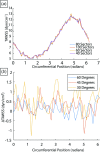A New Method for Quantifying Abdominal Aortic Wall Shear Stress Using Phase Contrast Magnetic Resonance Imaging and the Womersley Solution
- PMID: 35377416
- PMCID: PMC9125867
- DOI: 10.1115/1.4054236
A New Method for Quantifying Abdominal Aortic Wall Shear Stress Using Phase Contrast Magnetic Resonance Imaging and the Womersley Solution
Abstract
Wall shear stress (WSS) is an important mediator of cardiovascular pathologies and there is a need for its reliable evaluation as a potential prognostic indicator. The purpose of this work was to develop a method that quantifies WSS from two-dimensional (2D) phase contrast magnetic resonance (PCMR) imaging derived flow waveforms, apply this method to PCMR data acquired in the abdominal aorta of healthy volunteers, and to compare PCMR-derived WSS values to values predicted from a computational fluid dynamics (CFD) simulation. The method uses PCMR-derived flow versus time waveforms constrained by the Womersley solution for pulsatile flow in a cylindrical tube. The method was evaluated for sensitivity to input parameters, intrastudy repeatability and was compared with results from a patient-specific CFD simulation. 2D-PCMR data were acquired in the aortas of healthy men (n = 12) and women (n = 15) and time-averaged WSS (TAWSS) was compared. Agreement was observed when comparing TAWSS between CFD and the PCMR flow-based method with a correlation coefficient of 0.88 (CFD: 15.0 ± 1.9 versus MRI: 13.5 ± 2.4 dyn/cm2) though comparison of WSS values between the PCMR-based method and CFD predictions indicate that the PCMR method underestimated instantaneous WSS by 3.7 ± 7.6 dyn/cm2. We found no significant difference in TAWSS magnitude between the sexes; 8.19 ± 2.25 versus 8.07 ± 1.71 dyn/cm2, p = 0.16 for men and women, respectively.
Keywords: MRI; abdominal aortic aneurysm; biomechanics; cardiovascular risk; phase contrast magnetic resonance (PCMR); sex.
Copyright © 2022 by ASME.
Figures







Similar articles
-
Validation of numerical simulation methods in aortic arch using 4D Flow MRI.Heart Vessels. 2017 Aug;32(8):1032-1044. doi: 10.1007/s00380-017-0979-2. Epub 2017 Apr 25. Heart Vessels. 2017. PMID: 28444501 Free PMC article.
-
A modified method of computed fluid dynamics simulation in abdominal aorta and visceral arteries.Comput Methods Biomech Biomed Engin. 2021 Nov;24(15):1718-1729. doi: 10.1080/10255842.2021.1912742. Epub 2021 Sep 26. Comput Methods Biomech Biomed Engin. 2021. PMID: 34569360
-
Numerical simulation in the abdominal aorta and the visceral arteries with or without stenosis based on 2D PCMRI.Int J Numer Method Biomed Eng. 2022 Mar;38(3):e3569. doi: 10.1002/cnm.3569. Epub 2022 Jan 18. Int J Numer Method Biomed Eng. 2022. PMID: 34967124
-
How does hemodynamics affect rupture tissue mechanics in abdominal aortic aneurysm: Focus on wall shear stress derived parameters, time-averaged wall shear stress, oscillatory shear index, endothelial cell activation potential, and relative residence time.Comput Biol Med. 2023 Mar;154:106609. doi: 10.1016/j.compbiomed.2023.106609. Epub 2023 Jan 23. Comput Biol Med. 2023. PMID: 36724610 Review.
-
A comparison of 4D flow MRI-derived wall shear stress with computational fluid dynamics methods for intracranial aneurysms and carotid bifurcations - A review.Magn Reson Imaging. 2018 May;48:62-69. doi: 10.1016/j.mri.2017.12.005. Epub 2017 Dec 6. Magn Reson Imaging. 2018. PMID: 29223732 Review.
Cited by
-
Flow-based method demonstrates improved accuracy for calculating wall shear stress in arterial flows from 4D flow MRI data.J Biomech. 2023 Jan;146:111413. doi: 10.1016/j.jbiomech.2022.111413. Epub 2022 Dec 9. J Biomech. 2023. PMID: 36535100 Free PMC article.
-
Comparison of Prospective and Retrospective Gated 4D Flow Cardiac MR Image Acquisitions in the Carotid Bifurcation.Cardiovasc Eng Technol. 2023 Feb;14(1):1-12. doi: 10.1007/s13239-022-00630-6. Epub 2022 May 26. Cardiovasc Eng Technol. 2023. PMID: 35618870
-
Optimization of 4D Flow MRI Spatial and Temporal Resolution for Examining Complex Hemodynamics in the Carotid Artery Bifurcation.Cardiovasc Eng Technol. 2023 Jun;14(3):476-488. doi: 10.1007/s13239-023-00667-1. Epub 2023 May 8. Cardiovasc Eng Technol. 2023. PMID: 37156900 Free PMC article.
References
-
- Cheng, C. , Tempel, D. , Van Der Baan, A. , Krams, R. , Daemen, M. , Van Haperen, R. , Grosveld, F. , and De Crom, R. , 2006, “ Atherosclerotic Lesion Size and Vulnerability Are Determined by Patterns of Fluid Shear Stress,” Circulation, 113(23), pp. 2744–53.10.1161/CIRCULATIONAHA.105.590018 - DOI - PubMed
Publication types
MeSH terms
Grants and funding
LinkOut - more resources
Full Text Sources
Research Materials
Miscellaneous

